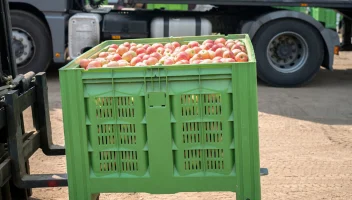How Food Logistics Software Helps Distributors Conquer 4 of the Industry’s Toughest Challenges
How Food Logistics Software Helps Distributors Conquer 4 of the Industry’s Toughest Challenges
How Food Logistics Software Helps Distributors Conquer 4 of the Industry’s Toughest Challenges
29 Jun 2022
Jim Endres
As a food distribution professional, you know well that your operations are complex. There are a multitude of considerations to take into account, from the nature of the goods being conveyed and seasonal surges in demand to fuel prices and clients’ unique preferences. Add on top of those matters the prevailing disruption of global supply chains, and it’s clear that your job as a distributor is anything but easy.
So what’s a business like yours to do? Even if you hire the most qualified people, train them well and fine-tune your internal processes to near-perfection, you’ll still likely face uncertainty due to market factors outside of your control. At the same time, you can’t just put your feet up and hope things turn out for the best—not in a space as competitive and dynamic as yours.
The answer involves getting the right technology on your side. Specifically, we’re referring to food logistics software, especially a routing and scheduling system equipped with specialised tools that help you manage the key concerns that modern distributors face.
Read on for a full run-down of these challenges and the solutions offered by purpose-built logistics platforms.
Challenge 1: Delivering Fresh, High-Quality Products
Fresh foods are inherently perishable, and some have shorter windows of viability than others. That puts pressure on you as a distributor to ensure that orders arrive on time and in the best shape possible to keep your clients happy. The quality of fruits, vegetables, baked goods, dairy and other items can really suffer if you fail in this regard.
Frozen foods may have a longer shelf life compared to fresh goods, but they too can become compromised in transport if the conditions inside your truck deviate from acceptable ranges for too long. And while you likely outfit your vehicles with the proper equipment to preserve such products if you deliver them, it’s still best that they’re delivered to the client efficiently to minimise the chances that they’re negatively affected.
Solution: Real-Time Tracking and ETA Updates
To combat the risks of transporting perishable items, it’s best to implement routing software that offers real-time tracking of your trucks and sends automatic alerts to both the distribution center from which the truck was dispatched as well as the clients expecting their order. This keeps everyone apprised of the progress and prompts intervention before the situation becomes a problem.
Another benefit of this feature is improved customer satisfaction, as updates on arrival times will help your recipients ensure that their personnel are ready to receive the delivery when it arrives with minimal interruptions of their other tasks. The additional transparency and visibility will also add to your reputation as a dependable supplier.
Challenge 2: Mitigating Rising Transportation Costs
For those who work in food distribution, it comes as no shock that the current trend of rising fuel costs can put a crimp in your company’s profitability. And with short-term predictions for the per-barrel price of oil reaching as high as £165—from approximately £66 at the end of 2021—the effect could be dramatic.
There’s also the matter of the ongoing trucker shortages in both the U.S. and Canada as well as the UK and the rest of Europe, which puts upward pressure on the expected wages and additional incentives in that field. While those jobs are critical and the people who perform them deserve to be paid well for their effort, there’s no denying the fact that this represents an additional financial outlay for your organisation.
Solution: Optimised Route Planning
To lessen the detrimental effects of these cost increases, your business needs to create optimised routes for your deliveries that keep fuel consumption to a minimum and make the best use of the drivers you have on staff. This would be very tricky to do with just a map and one employee’s know-how, but luckily, a good routing and scheduling system can automate this process and execute much faster than any individual.
Advanced platforms like Aptean Routing and Scheduling excel in this function by employing dynamic route optimisation technology that takes into account the many different variables and requirements in play. Hundreds of datapoints can be analysed all at once, producing routes within seconds that optimise efficiency, reduce truck miles and maximise both driver and vehicle utilisation.
projected per-barrel price of oil for summer 2022
Challenge 3: Adjusting Quickly for Variable Volumes
Whether it’s a heat wave in the dog days of summer that sends shoppers to the ice cream aisle in droves or a rush on seasonal favourites in December, spikes in demand come with the territory of the food and beverage industry. These surges lead to retailers putting in additional orders, and it falls to your organisation as the distributor to fulfill them or otherwise miss out on the extra revenue they offer.
Of course, you can’t be expected to purchase a whole new fleet or reprioritise your standing accounts and regular customers when opportunities like these arise. The secret to pleasing all parties and capitalising on the potential earnings in such situations lies in more effective scheduling.
Solution: Flexible and Dynamic Scheduling
The best scheduling tools provided by software for food distribution combine static routes with late, off-day and emergency orders to accommodate sudden increases in demand. This flexible “hybrid” model takes into account the unused capacity of trucks that would otherwise be on the road anyway and helps maximise your utilisation to cover your clients’ sometimes unpredictable needs.
Knowing that seasonal surges are on the horizon also helps you prepare in advance, and for that insight it’s smart to turn to the demand forecasting features of enterprise resource planning (ERP) solutions. Our own Aptean Food & Beverage ERP combines historical sales data with emergent trends to keep you informed on the chances of a spike in the near future, which will allow for any necessary ramp-up or securing of additional supplies.
Challenge 4: Meeting High Customer Expectations
You no doubt know from first-hand experience that no two clients are the same. You likely deliver to both retail locations like supermarkets and foodservice outlets, and each has their own set of specifications with regards to the times they can accept deliveries and the kinds of trucks that can dock at their facilities—or even fit in their parking lot.
It’s also safe to say that you’re well aware of how much a delay of even just 15 minutes can impact a relationship with a customer. Time is of the essence in food and beverage order fulfillment, and missing the requested window tends to prompt complaints or even push what was once a consistent client to consider an alternative supplier.
Solution: Configurable Parameters and Continuous Improvement
To help you consistently meet or exceed the requirements of your customers, a good route planning system will include configurable parameters within its interface to specify preferred time windows and vehicle varieties. This ensures that the routes generated by the system adhere reliably to the promises you’ve made your customers, even down to any requested driver certifications or preferred communication methods.
By choosing a food logistics software vendor that provides an integrated route planning, route execution and proof of delivery solution, you gain visibility and control over your entire distribution operation. This means you’re able to hold drivers accountable for their actions that impact customer satisfaction and even implement strategies to enhance service in the final mile.
For example, by comparing planned-versus-actual route data, you can coach drivers to avoid deviations from the schedule and minimise missed or late deliveries. In addition, using electronic proof of delivery software, you can streamline on-site customer processes or even implement satisfaction surveys.
Experience the Aptean Advantage
Getting the right food logistics software on your side can really be a game-changer for your food distribution business. As you’ve learned in this post, a good routing and scheduling system built with an in-depth understanding of the challenges that organisations like yours face day in and day out comes packed with highly useful features that help you tackle even the toughest issues.
One of the key differentiators of Aptean platforms is the industry expertise that our teams have and how decades of collective experience have gone into the development of our systems. That includes Aptean Routing & Scheduling, which saves money, increases efficiency and improves overall outcomes for our clients all over the world, as well as the rest of our complete solution suite.
Another reason to consider Aptean your preferred provider of business technologies is our approach to working with customers as partners throughout the implementation process and go-live phase. We can help your team build a roadmap for deployment, provide advice based on best practices and help you get the most out of your new system with dependable support going forward.
So, ready to learn more about Aptean Routing & Scheduling, Aptean Food & Beverage ERP or any of our other cutting-edge systems for food distribution companies like yours? Contact us today, or request a personalised demo.
Related Content





Ready to start transforming your food business?
We’ve got the specialised TMS solutions you need to conquer your food logistics and distribution challenges.



